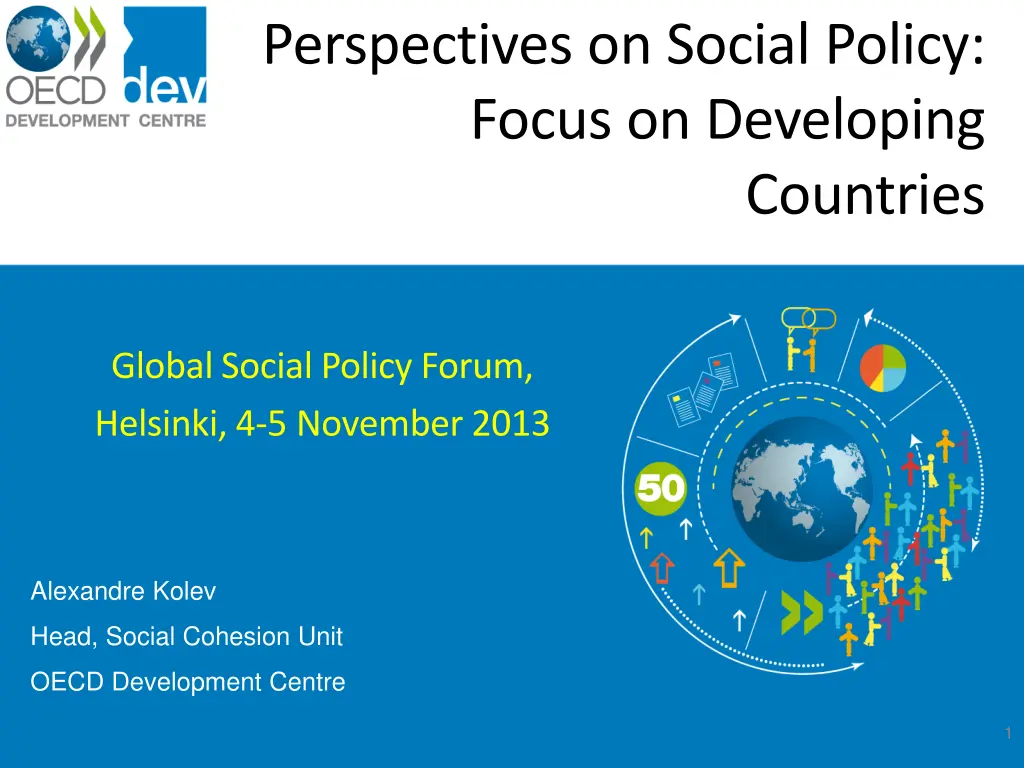
OECD Development Centre: Social Policy Perspectives & Initiatives
Explore the OECD Development Centre's efforts in providing effective policy solutions for growth, poverty alleviation, and reducing inequality in both OECD and non-OECD member countries. Discover key messages on social cohesion, policy challenges, and the importance of inclusive social policies for developing countries.
Download Presentation

Please find below an Image/Link to download the presentation.
The content on the website is provided AS IS for your information and personal use only. It may not be sold, licensed, or shared on other websites without obtaining consent from the author. If you encounter any issues during the download, it is possible that the publisher has removed the file from their server.
You are allowed to download the files provided on this website for personal or commercial use, subject to the condition that they are used lawfully. All files are the property of their respective owners.
The content on the website is provided AS IS for your information and personal use only. It may not be sold, licensed, or shared on other websites without obtaining consent from the author.
E N D
Presentation Transcript
Perspectives on Social Policy: Focus on Developing Countries Global Social Policy Forum, Helsinki, 4-5 November 2013 Alexandre Kolev Head, Social Cohesion Unit OECD Development Centre 1
About the OECD Development Centre To help policy makers in OECD and non-OECD member countries identify effective policy solutions for growth, poverty alleviation and the reduction of inequality, relevant to the diverse contexts of its member countries by: Producing multidisciplinary analysis on key development issues Providing an informal platform for policy dialogue and mutual learning between OECD and non-OECD countries 6/11/2025 2
The Centres Membership OECD members: 24 countries + EU Non-OECD members: 18 countries Israel Argentina Mauritius Austria Portugal Italy Brazil Morocco Belgium Slovakia Korea Colombia Panama Chile Spain Luxembourg Czech republic Sweden Costa Rica Peru Mexico Finland Switzerland Cape Verde Romania Dominican Republic France Netherlands Turkey Senegal Germany Norway United Kingdom Egypt South Africa European Commission Iceland Poland Thailand India Ireland Vietnam Indonesia
OECD work related to social policy In OECD countries OECD databases (social expenditures, social benefit recipients, pension, income support, family policies, income distribution, employment, health) Pension Review, Social and Labour Market Review In developing countries Social Cohesion and Policy Review Social Institutions and Gender Index (SIGI) country studies
Perspectives on Social Policy - Main messages 1. As economic uncertainty deepens, now is the time for developing countries to channel their recent prosperity into a more ambitious social cohesion agenda. 2. The process of rapid growth in many developing countries presents both a chance and risks for social cohesion. 3. Inclusive social policy is key for social cohesion.
Outline 1 Shifting Wealth: an unprecedented opportunity? 2 Challenges for social cohesion in fast growing countries 3 What policies for social cohesion? 4 Looking forward
The four-speed world in the 1990s Source: OECD Development Centre, Perspectives on Global Development 2010 - Shifting Wealth
The four-speed world in the 2000s Source: OECD Development Centre, Perspectives on Global Development 2010 - Shifting Wealth
Shifting Wealth: New resources for development Greater fiscal space in the 2000s vis- -vis the 1990s Fiscal revenue to GDP ratio (%) Source: Authors calculations based on World Bank (2011).
Resources for development in Africa 2000 1600 Tax revenue per capita ODA per capita 1200 USD 800 400 0 Madagascar Togo Malawi* Chad Algeria Seychelles Zambia Benin Mauritius Congo Liberia Cameroon Sierra Leone Mauritania Senegal Namibia Tanzania Morocco Gambia Mozambique Nigeria Mali Egypt Swaziland Central Afr. Rep. Guinea-Bissau Congo Dem. Rep. Angola Kenya Sudan Niger AFRICAN MEDIAN Tunisia Ethiopia Burundi Ghana** Botswana Burkina Faso Cape Verde Libya Comoros** S o Tom & Principe Uganda South Africa Gabon Djibouti Lesotho Rwanda C te d'Ivoire Guinea AFRICAN AVERAGE Equatorial Guinea Source: OECD/AfDB/UNECA (2010), African Economic Outlook
Outline 1 Shifting Wealth: an unprecedented opportunity? 2 Challenges for social cohesion in fast growing countries 3 What policies for social cohesion? 4 Looking Forward
Economic growth, but not for everyone Changes in welfare distribution across regions (Gini index of income distribution) MENA Southeast Asia Sub-Saharan Africa Latin America Note: An asterisk (*) indicates that the Gini index has been measured from income data. If not specified, Gini index is calculated from consumption data. Source: OECD calculation based on PovcalNet. 12
Fast growth, rising inequalities Absolute vs. relative poverty in China and Brazil, 1981-2007 Source: OECD (2012) Perspectives on Global Development : Social cohesion in a shifting world.
Distance matters as countries grow Incidence of absolute vs. relative poverty (percentage of the population) MENA Latin America Southeast Asia Sub-Saharan Africa Note: latest year available in the 2000s Source: Garroway and de Laiglesia (forthcoming) based on PovcalNet.
Different countries and income classes in global income distribution in 2008 90 100 percentile of world income distribution USA Brazil 80 70 60 50 Russia 40 China 30 20 India 10 1 1 20 40 country percentile 60 80 100 From Branko Milanovic
Real income growth at various percentiles of global income distribution, 1988-2008 (2005 PPPs) 80 X China s middle class $PPP 2 $PPP 110 70 60 $PPP4 $PPP11 50 40 x 30 20 X US lower middle class Branko Milanovic 10 0 0 10 20 30 40 50 60 70 80 90 100 Percentile of income distribution From Branko Milanovic
The missing middle in social protection coverage Share of the working population by income quintile and labour status in Brazil (2006) Source: da Costa et al. (2011).
Outline 1 Shifting Wealth: an unprecedented opportunity? 2 Challenges for social cohesion in fast growing countries 3 What policies for social cohesion? 4 Looking forward
What policies for social cohesion? Policies can make a difference Key areas: Fiscal, employment, social and educational policies A social cohesion agenda is a more ambitious social agenda: Poverty reduction + increased attention to vulnerable middle class + inclusive policies. Exploiting linkages between different policies is crucial : policy coherence and co-ordination.
Policies can make a difference for inequality The impact of taxes and transfers on income inequality, regional averages (ca. 2000s) Source: ILO 2011.
Social policy across the distribution in Brazil Growth incidence curve (2001-06) Real minimum wage (in end 1994 R$) 12 200 10 150 8 100 6 50 4 2 0 01-Dec-06 01-Dec-94 01-Dec-97 01-Dec-00 01-Dec-03 01-Dec-09 01-Jun-96 01-Jun-99 01-Jun-02 01-Jun-05 01-Jun-08 0 0 20 40 60 80 100 Growth rate by income percentile Growth rate in mean Source: PGD 2012 Source: IBGE and Central Bank of Brazil
Labour and social cohesion: Increase in labour disputes in China 800 Number of Labor Dispute Cases 600 (thousand) 400 200 0 1999 2000 2001 2002 2003 2004 2005 2006 2007 2008 2009 Source: Cai and Wang (2011)
Labour markets: Reforming labour institutions (China) Responses: increase in minimum wages and wider use of collective bargaining (1999 = 100) Average minimum wage in Chinese cities Number of collective contracts (left axis) Thousand Million 1 000 100 Number of employees covered (right axis) 300 900 90 800 80 250 700 70 200 600 60 150 500 50 400 40 100 300 30 50 200 20 0 100 10 1999 2000 2001 2002 2003 2004 2005 2006 2007 2008 2009 2010 0 0 1998 1999 2000 2001 2002 2009 Source: Authors calculations based on Du and Pan (2009) and CASS. Source: Cai and Wang (2011).
The role of social policy through a social mobility lens Correlation between parental and child education non-OECD economies OECD countries Source: Hertz et al. (2007), Intergenerational Economic Mobility around the World , The B.E. Journal of Economic Analysis & Policy, Vol.7, No. 2, pp.1-45.
Outline 1 Shifting Wealth: an unprecedented opportunity? 2 Challenges for social cohesion in fast growing countries 3 What policies for social cohesion? 4 Looking forward
Summary and Looking Forward Shifting wealth: Opportunities and risks Social cohesion as a means and an end More resources and unprecedented possibilities New opportunities not equally shared Rising middle classes in developing countries also at risks Looking forward Remaining questions: evolution of worldwide economic environment, sustainability and social cohesion, global governance. How to integrate inclusive social policy a part of national development strategies?


